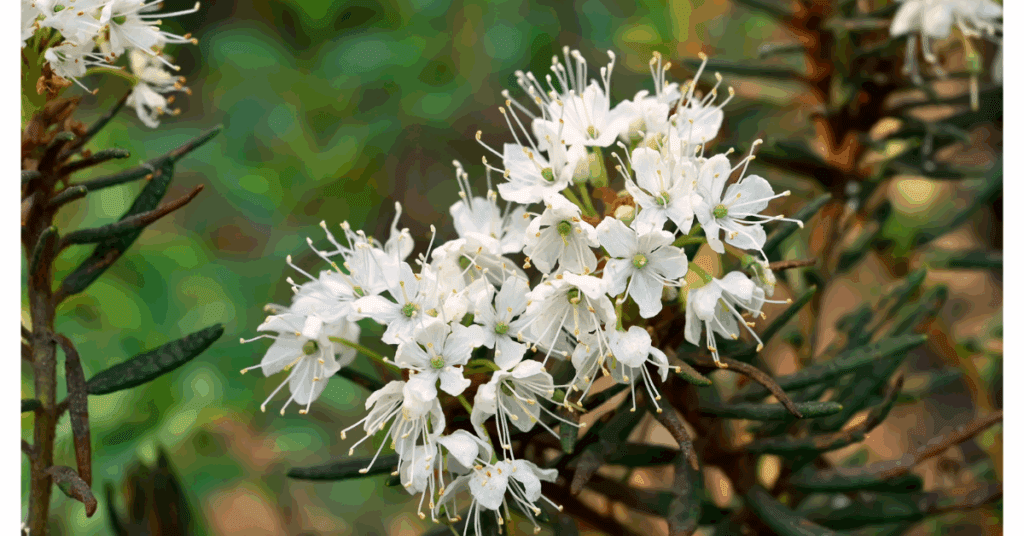
Ledum palustre
Latin name: Ledum palustre
Short name: Led
Common name: Marsh Labrador tea | Wild rosemary | Marsh tea | Swamp tea | Northern Labrador tea
Primary miasm: Psoric Secondary miasm(s): Syphilitic
Kingdom: Plants
Family: Ericaceae
- Symptomatology
- Remedy Information
- Differentiation & Application
Ledum palustre is a small evergreen shrub native to the cold, marshy regions of northern and central Europe, Asia, and North America. It belongs to the Ericaceae (heath) family. The leaves are aromatic, with a bitter, astringent taste and a narcotic odour when crushed. The plant contains volatile oils including ledol, which are known for their narcotic and irritant effects.
Traditionally, it has been used in folk medicine for its anti-inflammatory and sedative effects. In earlier times, it was employed to treat rheumatism, respiratory ailments, and insect bites, though large doses were known to be toxic. Native American tribes used it as a poultice for wounds and in infusions for colds. In veterinary use, it was used to repel lice and parasites.
Proved by Hahnemann and later expanded by Jahr and Hering. The proving was conducted using tincture and triturations of the fresh plant, with several reliable symptom accounts documented.
Ledum acts most profoundly on the joints, especially the small joints, producing inflammation, stiffness, and pain. It has a marked action on the skin and puncture wounds, particularly those from insect bites, animal bites, and stings. It affects the nervous system, producing a chilly, paralytic state with numbness or coldness of parts. The remedy also influences the connective tissues, especially in relation to trauma, bruising, and gout. The eyes, especially in the context of injuries, and the feet, with specific aggravation from stepping or standing, are key spheres of action. Its influence on blood, particularly in septic or ecchymotic tendencies, is also notable.
- Cold applications
- Rest
- Lying down
- Soaking affected parts in cold water
- Elevation of limbs
- Heat, especially of bed
- Night
- Motion
- Touch
- Alcohol
- Injury, trauma, or puncture wounds
- Suppressed discharges or eruptions
- Arnica montana – Also used for trauma, but Ledum is better for puncture wounds and complaints better from cold. Arnica is worse from touch and pressure.
- Hypericum perforatum – Also for puncture wounds, especially with nerve pain. Ledum is more suited for cold, inflammation, and gouty conditions.
- Rhus toxicodendron – For joint pain, but Rhus-t is better from motion, while Ledum is worse.
- Apis mellifica – For stings and bites, but Apis is warm and puffy, Ledum is cold and bluish.
- Bryonia alba – Joint pain aggravated by motion, but Bryonia prefers pressure and warmth, unlike Ledum.
- Complementary: Hypericum, Arnica, Apis
- Antidotes: Camphor, Belladonna
- Inimical: Rhus tox. (often incompatible in acute stages)
- Follows Well: Arnica, Rhus tox.
- Precedes Well: Sulphur (in skin cases)
The essence of Ledum is coldness, inflammation, and stasis—physical and emotional. It is the remedy for wounds that do not bleed, cold joints that swell, and bites that turn blue. It embodies a system that fails to expel—whether toxins, emotions, or heat—and instead retains, hardens, and stagnates. There is a silent, brooding quality to the Ledum patient—unexpressed anger, slow reaction, and hidden pain. Cold compresses soothe their pain, and solitude suits their mind. From trauma to gout to puncture wounds, Ledum acts where others have failed.
Ledum is a first-choice remedy for insect bites, animal bites, and puncture wounds, especially when pain is better for cold and the affected part is swollen and bluish. It prevents tetanus in puncture wounds and should be used immediately after trauma. It is invaluable in black eyes, concussions, and bruising, especially when the skin is cold and discoloured. For gout, especially when beginning in the feet and ascending, Ledum is often curative. It is also suited to chronic joint pain, chillblains, and rheumatism that worsens with warmth and improves with cold. Think of Ledum wherever there is cold, bruised pain, and scanty discharges.
In acute injuries such as bites, stings, and puncture wounds, Ledum is best administered in 30C or 200C, repeated frequently at first (every hour or two), then spaced as improvement sets in. For chronic rheumatic or gouty conditions, 200C to 1M may be used, often once daily or weekly, depending on vitality. In trauma cases, it may follow or alternate with Arnica or Hypericum depending on the tissues affected. Sensitive patients may benefit from lower potencies such as 6C or 12C, especially in long-standing joint complaints.
Mind
- Indifference to company
- Ailments from suppressed anger
Head
- Headache, after injury
- Scalp, sore to touch
Eyes
- Black eye
- Ecchymosis around eyes from trauma
Extremities
- Gout, beginning in feet
- Arthritis, small joints
- Ankle pain, worse for motion, better for cold
Skin
- Puncture wounds
- Insect bites
- Chilblains
- Ecchymosis from slight trauma
Generalities
- Better from cold applications
- Worse from warmth
- Injuries, punctured wounds
Hahnemann – Materia Medica Pura: Original proving
F. Allen – Encyclopaedia of Pure Materia Medica: Comprehensive proving symptoms
Hering – Guiding Symptoms: Detailed clinical and chronic confirmations
John Henry Clarke – Dictionary of Practical Materia Medica: Comparisons and keynotes
T. Kent – Lectures on Homoeopathic Materia Medica: Mental picture and keynote usage
Boericke – Pocket Manual: Therapeutic applications and remedy relationships
